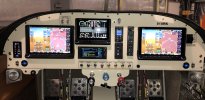I have a Skyview 3 screen setup in my RV10. I have a 10” screen on each side set up as PFD’s and a 7” screen in the middle for engine instruments. When I originally installed the ADAHARS I did what the Dynon manual said and used a splitter to join the the ADAHARS together and run one cable forward to the rest of my network. I think this is the wrong thing to do. That 1 cable, and especially the D9 connectors at each end, represents a single point of failure for both ADAHARS. Not only that but the network cable going from a 5 port hub on the right side to the co-pilots EFIS is also another possible failure point that would also leave the system with no attitude or air data.
I just ordered another cable to correct this issue. I have two 5 port hubs in my system, one on each side of the cockpit. The current cable is connected to the right side and I am going to connect the new cable to the left side 5 port hub. The rest of the units are daisy chained between these 2 hubs. This way a failure on either side, or somewhere in the middle with a failed network cable, would still leave me with at least one good ADAHARS on at least one screen. This might not be important for a VFR only aircraft. However for even an occasional IFR aircraft this is really important.
I am not running another standalone attitude indicator. With 2 ADAHARS and 3 screens to see the data I have far better redundancy than any of the other light aircraft I have ever flown. I have the standby batteries for all 3 screens and I have 2 B&C alternators.
If I flew this aircraft in IMC all the time I would have probably figured out a way to put in a third attitude indicator. However I am not flying jets in all kinds of dastardly weather anymore and I have more brains than to fly my RV10 into possible icing conditions. I have the skill to fly approaches down to minimums and even land without seeing the runway, but I sure don’t plan on using those skills in the RV10.
I just ordered another cable to correct this issue. I have two 5 port hubs in my system, one on each side of the cockpit. The current cable is connected to the right side and I am going to connect the new cable to the left side 5 port hub. The rest of the units are daisy chained between these 2 hubs. This way a failure on either side, or somewhere in the middle with a failed network cable, would still leave me with at least one good ADAHARS on at least one screen. This might not be important for a VFR only aircraft. However for even an occasional IFR aircraft this is really important.
I am not running another standalone attitude indicator. With 2 ADAHARS and 3 screens to see the data I have far better redundancy than any of the other light aircraft I have ever flown. I have the standby batteries for all 3 screens and I have 2 B&C alternators.
If I flew this aircraft in IMC all the time I would have probably figured out a way to put in a third attitude indicator. However I am not flying jets in all kinds of dastardly weather anymore and I have more brains than to fly my RV10 into possible icing conditions. I have the skill to fly approaches down to minimums and even land without seeing the runway, but I sure don’t plan on using those skills in the RV10.

